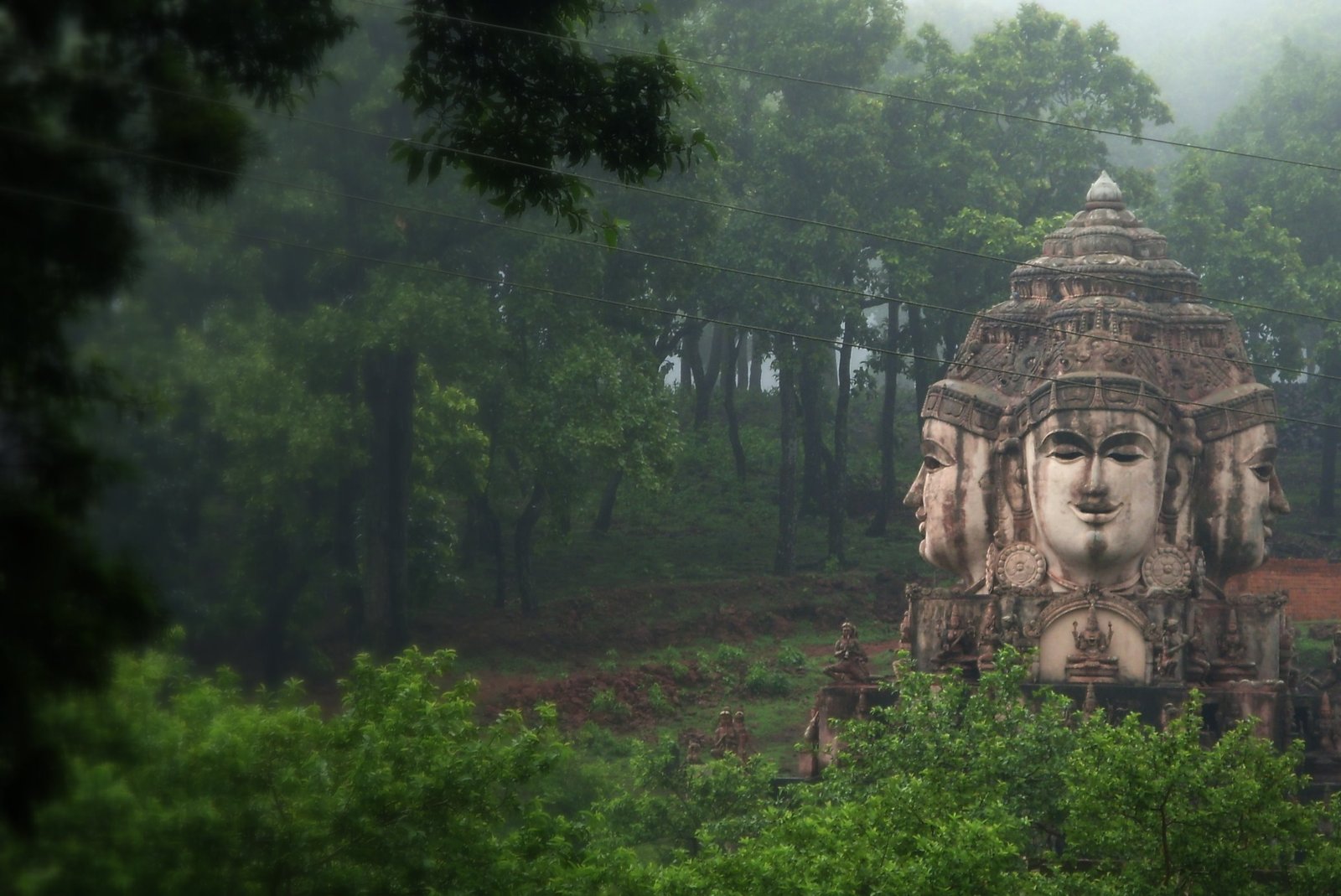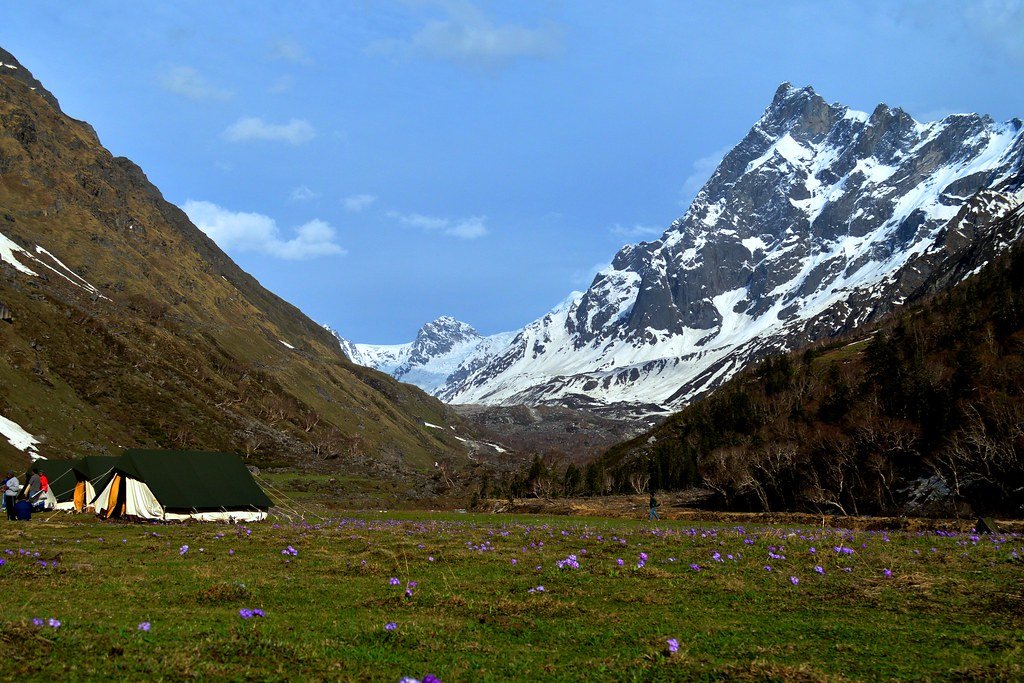20 Places To Visit In Amarkantak | How To Reach | Complete Tour Guide
Amarkantak, located in Madhya Pradesh, India, is a spiritually significant town known for being the source of sacred rivers like Narmada and Sone. With ancient temples, including Shri Yantra Mandir and Jwaleshwar Mahadev Temple, the town is a religious hub. Surrounded by lush landscapes and waterfalls like Dudh Dhara, Amarkantak offers a picturesque setting. Historical sites such as Pataleshwar Mahadev Temple add to its charm. The Achanakmar Wildlife Sanctuary nearby showcases diverse flora and fauna. Amarkantak’s cultural heritage, tranquil atmosphere, and blend of spirituality and natural beauty make it a unique destination for pilgrims and tourists.

Best Places To Visit In Amarkantak:
Amarkantak features the sacred Narmada Kund, the Narmada Temple, and the Kabir Chabutra. The Sonmuda Valley offers stunning landscapes, while the Achanakmar Wildlife Sanctuary showcases rich biodiversity, making Amarkantak an ideal retreat for nature lovers and spiritual seekers alike.
Here are some places to visit in Amarkantak:
1. Narmada Kund:
Narmada Kund, situated in Amarkantak, Madhya Pradesh, India, holds great religious significance as it is considered the origin of the sacred Narmada River. Pilgrims and devotees frequent this spot to witness the symbolic emergence of the Narmada. The kund, or reservoir, is a revered pilgrimage site, surrounded by a tranquil atmosphere and lush greenery. The spiritual aura, coupled with the natural beauty of the surroundings, makes Narmada Kund a place of reverence and peaceful contemplation. Visitors often engage in rituals and prayers, contributing to the serene ambiance of this sacred water source.

2. Sone River:
The Sone River, originating near the Narmada Kund in Amarkantak, Madhya Pradesh, India, is a significant watercourse with cultural and geographical importance. The river holds spiritual significance, often intertwined with local traditions and beliefs. According to legend, the origin of the Son River is believed to be associated with Brahma, the divine creator. As a result of Brahma’s penance, the Son River emerged from his left eye as gold (son) and from his right eye as a stream of tears known as Bhadra. This celestial flow, often referred to as Son-Bhadra, is more commonly recognized by the name Son. The source of the Sone River in Amarkantak adds to its reverence, and the journey of the river as it courses through diverse terrains offers opportunities for scenic exploration. From lush green surroundings near its origin to the vast plains it traverses, the Sone River remains an integral part of the cultural and ecological tapestry of central India.

3. Shri Yantra Mandir:
Shri Yantra Mandir, is a sacred temple designed as a three-dimensional representation of the renowned Shri Yantra, also known as Sri Chakra. The temple is constructed in the form of a Maha Meru Yantra, representing the 3D manifestation of Shri Yantra, and is envisioned to be the Shri Yantra Maha Meru Shaktipeeth. Commencing its construction in 1991, the temple is anticipated to be completed within the next seven to eight years. Positioned on the revered land of the Narmada River’s origin in Amarkantak, Anuppur District, Madhya Pradesh, the temple has become a popular tourist attraction celebrated for its historical and cultural significance.

4. Kabir Chabutra:
Kabir Chabutra, is a significant pilgrimage site associated with the teachings of the renowned saint Kabir. This sacred platform is believed to be the spot where Saint Kabir preached his spiritual wisdom and philosophical insights. Pilgrims and devotees visit Kabir Chabutra to pay homage to the saint and absorb the tranquil atmosphere, contemplating the profound teachings that resonate from this historical site. The chabutra serves as a serene and peaceful place for reflection, attracting those seeking spiritual solace and a connection to the teachings of Saint Kabir.

5. Sonemuda:
Sonemuda is a picturesque location near Amarkantak in Madhya Pradesh, where the revered Sone River emerges from the hills. This scenic spot is surrounded by lush greenery and natural beauty, offering visitors a serene and tranquil environment. Pilgrims and nature enthusiasts often visit Sonemuda to witness the sacred origin of the Sone River and to appreciate the serene landscapes that characterize the area. The gentle flow of the river, combined with the peaceful ambiance, makes Sonemuda a delightful destination for those seeking spiritual connection and a respite in the lap of nature.

6. Pataleshwar Mahadev Temple:
Pataleshwar Mahadev Temple, is a unique and ancient Shiva temple with distinctive features. What sets it apart is its underground sanctum, providing a spiritual experience unlike conventional temple structures. The temple is believed to be connected to the netherworld, adding an air of mystique to its ambiance. Devotees and visitors are drawn to Pataleshwar Mahadev Temple not only for its religious significance but also for the awe-inspiring architectural concept. The underground chamber, dedicated to Lord Shiva, is adorned with religious motifs, creating an atmosphere of divine sanctity. This historical site stands as a testament to the rich cultural and spiritual heritage of Amarkantak.

7. Dudh Dhara Waterfall:
Dudh Dhara Waterfall, is a captivating natural wonder. The waterfall derives its name, which translates to “milky stream,” from the frothy appearance of the cascading water. Set against a backdrop of lush greenery, Dudh Dhara offers a serene and picturesque setting, making it a popular attraction for both pilgrims and nature enthusiasts. The waterfall is formed as the Narmada River descends from the plateau, creating a mesmerizing sight and a tranquil ambiance. Visitors are drawn to Dudh Dhara to witness the harmonious blend of natural beauty and spiritual significance that characterizes the region. The cascading waters, surrounded by verdant foliage, make Dudh Dhara a delightful destination for those seeking both serenity and the awe-inspiring spectacle of nature.

8. Kapil Dhara Waterfall:
:Kapil Dhara Waterfall, is a breathtaking natural spectacle surrounded by pristine landscapes. Named after the sage Kapil, who is said to have dedicated approximately 12 years to meditation at this location. this waterfall holds cultural and spiritual significance in addition to its natural allure. The cascade is formed as the Narmada River descends from the plateau, creating a mesmerizing display of nature’s beauty. The lush green surroundings enhance the charm of the waterfall, making it a popular destination for both pilgrims and nature enthusiasts. Whether seeking a spiritual retreat or simply admiring the wonders of nature, Kapil Dhara Waterfall offers a captivating experience in the heart of Amarkantak.

9. Achanakmar Wildlife Sanctuary:
Achanakmar Wildlife Sanctuary, was established in 1975 under the Indian Wildlife Protection Act of 1972. Designated as a Tiger Reserve under Project Tiger in 2009, the sanctuary covers an expansive area of 557.55 square kilometers, renowned for its diverse flora and fauna. Among its inhabitants are endangered species such as leopards, Bengal tigers, and wild bison. The sanctuary also holds a legendary tale of a sudden tiger attack and shares connections with Kanha and Bandhavgarh Tiger Reserves. Open daily from 6:00 AM to 6:00 PM, the sanctuary welcomes visitors, with an entry fee of INR 25 for Indians and INR 200 for foreigners.

10. Kalyani (Stepped Tank):
Kalyani, also known as the Stepped Tank, is a historic reservoir located in Amarkantak. This architectural marvel serves both practical and ritualistic purposes, showcasing a unique stepped design that enhances its aesthetic appeal. Pilgrims and visitors often frequent Kalyani not only to witness its intricate craftsmanship but also to partake in religious rituals and ceremonies. The stepped tank, with its symmetrical arrangement of stairs leading to the water, reflects the cultural and historical significance of the region. Kalyani stands as a testament to the ancient engineering prowess and artistic sensibilities of the people who crafted this water structure. The serene ambiance surrounding the tank makes it a tranquil spot for reflection and spiritual contemplation, adding to the cultural allure of Amarkantak.

11. Sarvodaya Jain Temple:
Sarvodaya Jain Temple, is a revered pilgrimage site for followers of Jainism. This sacred temple is dedicated to Bhagwan Adinath, the first Tirthankara, and stands as a testament to Jain architectural and artistic traditions. The temple complex boasts intricate carvings and sculptures that depict Jain mythology and principles. The temple’s adorned with ornate details, reflects the rich cultural heritage of Jainism. Surrounded by a peaceful ambiance, the Sarvodaya Jain Temple invites pilgrims and enthusiasts alike to experience the spiritual essence and architectural beauty inherent in this sacred site.

12. Kabir Kuti:
Kabir Kuti, is a place of spiritual significance associated with the revered saint Kabir. Also known as Kabir’s Cottage, it is believed to be the spot where Saint Kabir meditated and imparted his profound spiritual teachings. The modest cottage stands as a symbol of simplicity and devotion, attracting pilgrims and followers of Kabir’s philosophy. Visitors to Kabir Kuti are drawn not only to its historical importance but also to the serene surroundings that evoke a sense of tranquility and contemplation. Pilgrims often gather at this sacred site to pay homage to Saint Kabir and reflect on his timeless teachings. Kabir Kuti, nestled in the heart of Amarkantak, serves as a quiet retreat for spiritual seekers and those seeking a connection to the profound wisdom of Saint Kabir.

13. Jwaleshwar Mahadev Temple:
Jwaleshwar Mahadev Temple, is dedicated to Lord Shiva, a prominent deity in the Hindu pantheon. Located approximately 10 km from the town of Amarkantak and northeast of the Narmada Temple, the temple holds a significant legend. According to the myth, when Lord Shiva vanquished the demon Tripurasura, one of the three parts fell near Narmadakund, becoming the divine abode of Lord Shiva. The temple enshrines a black Shiva lingam named Jwaleshwar Mahadev. Open from 8 AM to 6 PM, the temple invites devotees to experience its spiritual aura and pay homage to Lord Shiva.

14. Kamadhenu Temple:
Kamadhenu Temple, is a sacred Hindu shrine dedicated to the divine cow Kamadhenu. Constructed in (1996), the village is characterized by a significant stone displaying distinct cow hoof imprints. In the northern section of the village stands the KOTA Durga temple, contributing to the local designation of Khurkot. According to belief, the cow hoof marks on the stone are attributed to Kamadhenu, the divine cow deity. Devotees visit to seek blessings for prosperity and wishes fulfillment. The temple, set in scenic surroundings, offers a serene ambiance for worship and reflection, inviting pilgrims to connect with the divine in the tranquil landscapes of Amarkantak.

15. Kumarmani Mahadev Temple:
Kumarmani Mahadev Temple,is a sacred Hindu shrine dedicated to Lord Shiva. This temple holds cultural and spiritual significance, drawing devotees and visitors with its serene atmosphere and architectural beauty. Pilgrims frequent Kumarmani Mahadev Temple to seek blessings, offer prayers, and experience the divine aura that permeates this sacred site in the picturesque surroundings of Amarkantak. The temple stands as a testimony to the rich religious heritage of the region, inviting worshippers to connect with the divine and partake in the spiritual ambiance of Amarkantak.
16. Shri Radha Madhav Temple:
Shri Radha Madhav Temple, is a revered Hindu shrine dedicated to the divine couple, Radha and Madhav (Lord Krishna). This temple holds significant cultural and spiritual importance, attracting devotees seeking a connection with the divine. The serene surroundings of Amarkantak enhance the tranquil atmosphere of the temple, providing a peaceful setting for worship and reflection. Shri Radha Madhav Temple stands as a symbol of devotion and serves as a spiritual retreat for pilgrims and visitors alike, inviting them to experience the sacred aura of this holy site.
17. Bhrigu Kamandal:
Bhrigu Kamandal, is a revered site associated with the sage Bhrigu in Hindu mythology. The term “Kamandal” refers to a water pot traditionally carried by sages, and it is believed that Sage Bhrigu used a Kamandal to bring the Narmada River to Amarkantak. A modest cave where Sage Bhrigu is believed to have undertaken his spiritual practice. A rock, identified as the water vessel used by the sage, still contains water sourced from the rocks. Adjacent to it is a Shiva lingam. Accessible only after a 2-kilometer trek through rocky terrain, visitors can obtain water from the rock vessel and offer it to the Shiva lingam for blessings. Situated in a forested area, it is advisable to embark on the journey during daylight. Pilgrims visit Bhrigu Kamandal to pay homage to the sage and witness the sacred water source attributed to his mystical actions. The site, enveloped in spiritual significance, offers devotees a serene atmosphere for prayers and reflection, making it an integral part of Amarkantak’s religious landscape.

18. Trimukhi Temple:
Trimukhi Temple, is a sacred Hindu shrine dedicated to the Trimukhi form of Lord Shiva. This ancient temple is characterized by three faces of Lord Shiva, symbolizing the cosmic aspects of creation, preservation, and destruction. Pilgrims and devotees visit Trimukhi Temple to seek the divine blessings of Lord Shiva and experience the spiritual aura that surrounds this holy site. The temple’s architectural design and spiritual significance make it a focal point of worship and reverence in Amarkantak. Trimukhi Temple stands as a symbol of devotion and cosmic energy, inviting worshippers to connect with the divine in the tranquil surroundings of Amarkantak’s religious landscape.

19. Sonakshi Shaktipeeth Temple:
Sonakshi Shaktipeeth Temple, nestled in Amarkantak, Madhya Pradesh, India, is a revered Hindu temple dedicated to Goddess Durga in her divine form as Shakthi. Recognized as one of the 51 Shakthi Peethas, this sacred temple holds significant religious importance.
When Sati, the consort of Shiva, immolated herself during the Yajna conducted by her father Daksha, an anguished Shiva began performing the dance of destruction with her lifeless body. Witnessing this, the gods feared impending doom. In response, Vishnu, armed with his bow, severed Sati’s body into fifty-one pieces with his arrows. Each fragment that fell to the earth marked the creation of a Shakti Peetha. It is at this location where the Divine Mother’s left buttock is said to have descended, venerated in the forms of Kali, while Bhairava is revered as Asitang. This temple complex is renowned for its sunrise viewpoint.

20. Mai Ki Bagiya:
Mai Ki Bagiya, is a serene garden and religious site with cultural significance. Translating to “Mother’s Garden,” it is dedicated to the nurturing and worship of the divine feminine energy. According to a prevalent folk tale among the villagers, Narmada used to play at this place with her friend, a beautiful girl named Gulabkavali, who was 12 years old at the tender age. Hence, Narmada came to be known as “Narmadamaai.” In reality, ‘Gulabkavali’ is a representation of a plant in this context. This peaceful and beautifully landscaped garden provides a tranquil setting for devotees and visitors to engage in prayers, meditation, and spiritual reflection. Mai Ki Bagiya stands as a place of reverence and natural beauty, inviting pilgrims to experience a harmonious blend of spirituality and the serene ambiance of Amarkantak’s sacred landscapes.
These were some places to visit in Amarkantak. Hope you liked it. Have a safe journey!
How To Reach
- By Train:
- The nearest major railway station to Amarkantak is Pendra Road Railway Station (approximately 40 km away).
- You can take a train from New Delhi Railway Station to Pendra Road.
- From Pendra Road, you can hire a taxi or take a bus to reach Amarkantak.
Here are list of trains from delhi to Amarkantak:
| Train No. | Train Name | Distance (Approx.) | Departure Time | Arrival Time |
|---|---|---|---|---|
| 20808 | Nizamuddin-Pendra Road Express | 803.9 km | 21:35 (New Delhi) | 15:19 (Pendra Road) |
By Air and Road:
The nearest airport to Amarkantak is Dumna Airport in Jabalpur (approximately 245 km away).
From Jabalpur, you can hire a taxi or take a bus to reach Amarkantak.
Alternatively, you can also consider flying to Raipur Airport (approximately 300 km away) and then take a road journey.
By Road:
Amarkantak is well-connected by road. You can take a bus from the inter-state bus terminals in Delhi to reach Amarkantak.
Alternatively, you can drive or hire a taxi for a more flexible and comfortable journey.
Nearby Places To Visit:
Here are five popular cities near Amarkantak along with their approximate distances:
| Tourist City | Distance from Amarkantak |
|---|---|
| Bilaspur | 122 km |
| Umaria | 175 km |
| Kanha National Park | 190 km |
| Raipur | 221 km |
| Jabalpur | 226 km |
These cities offer diverse experiences and are worth exploring during your visit to Amarkantak! 🌄🚗.




